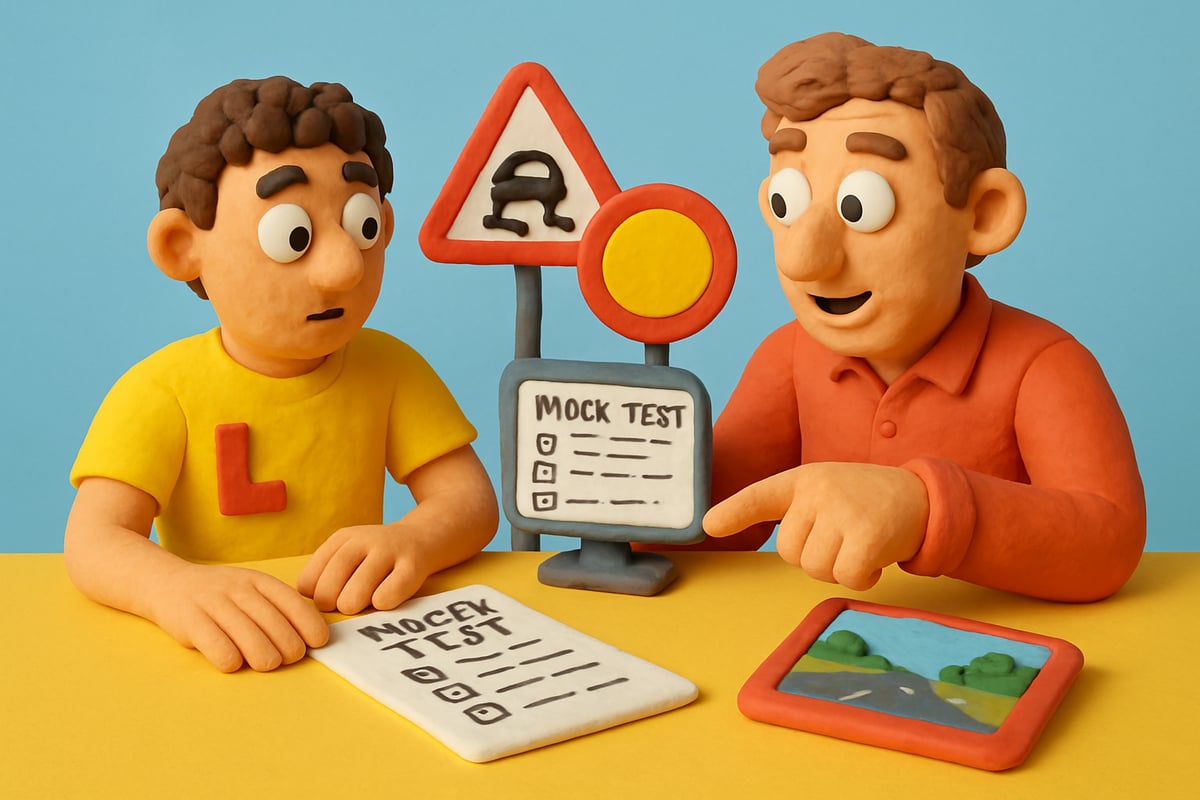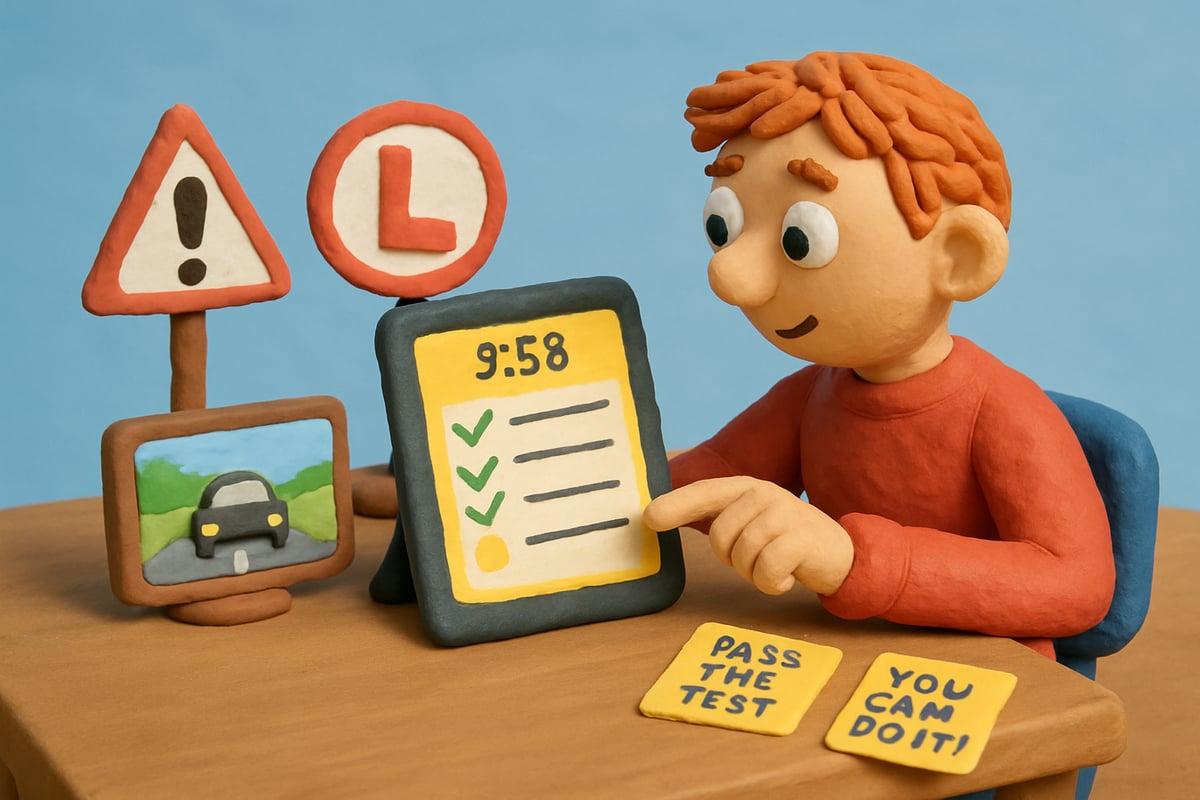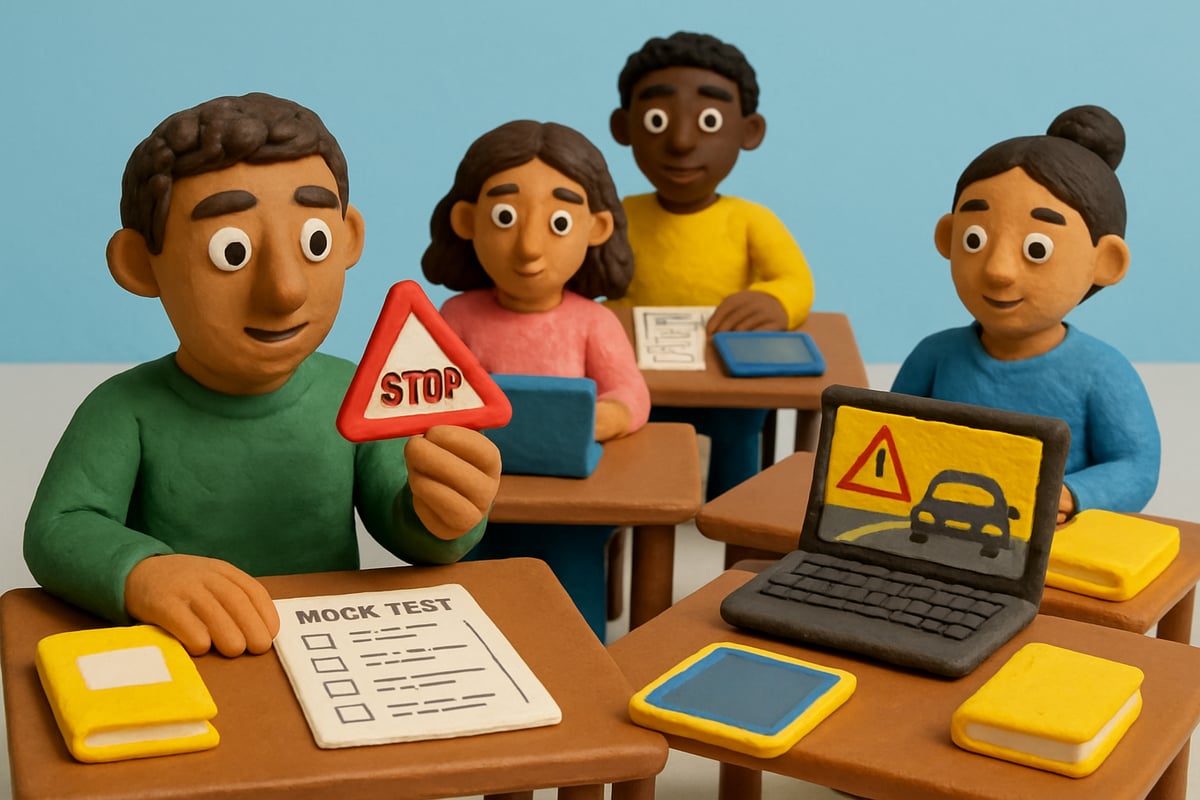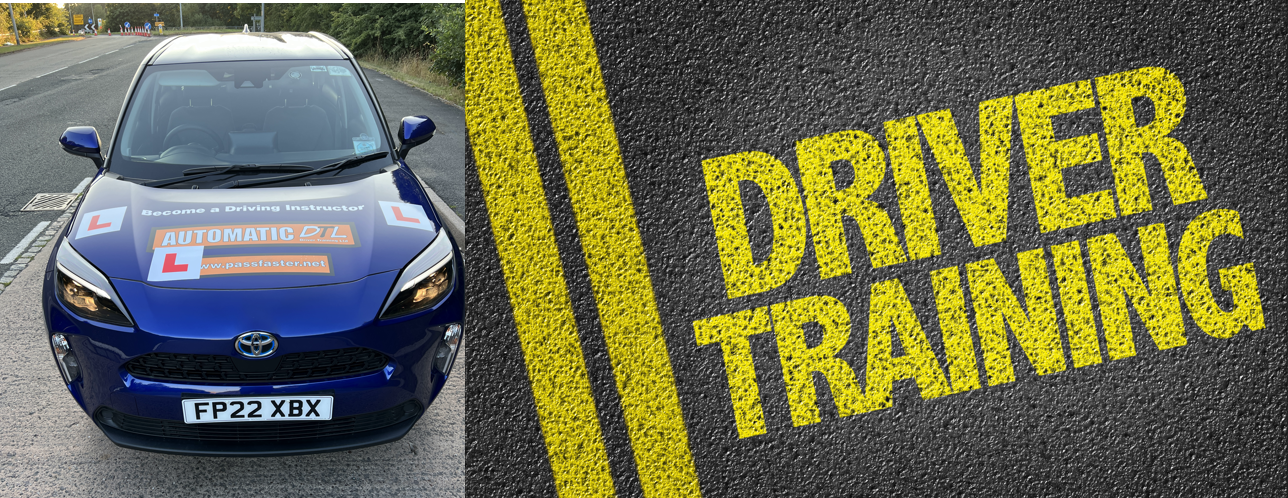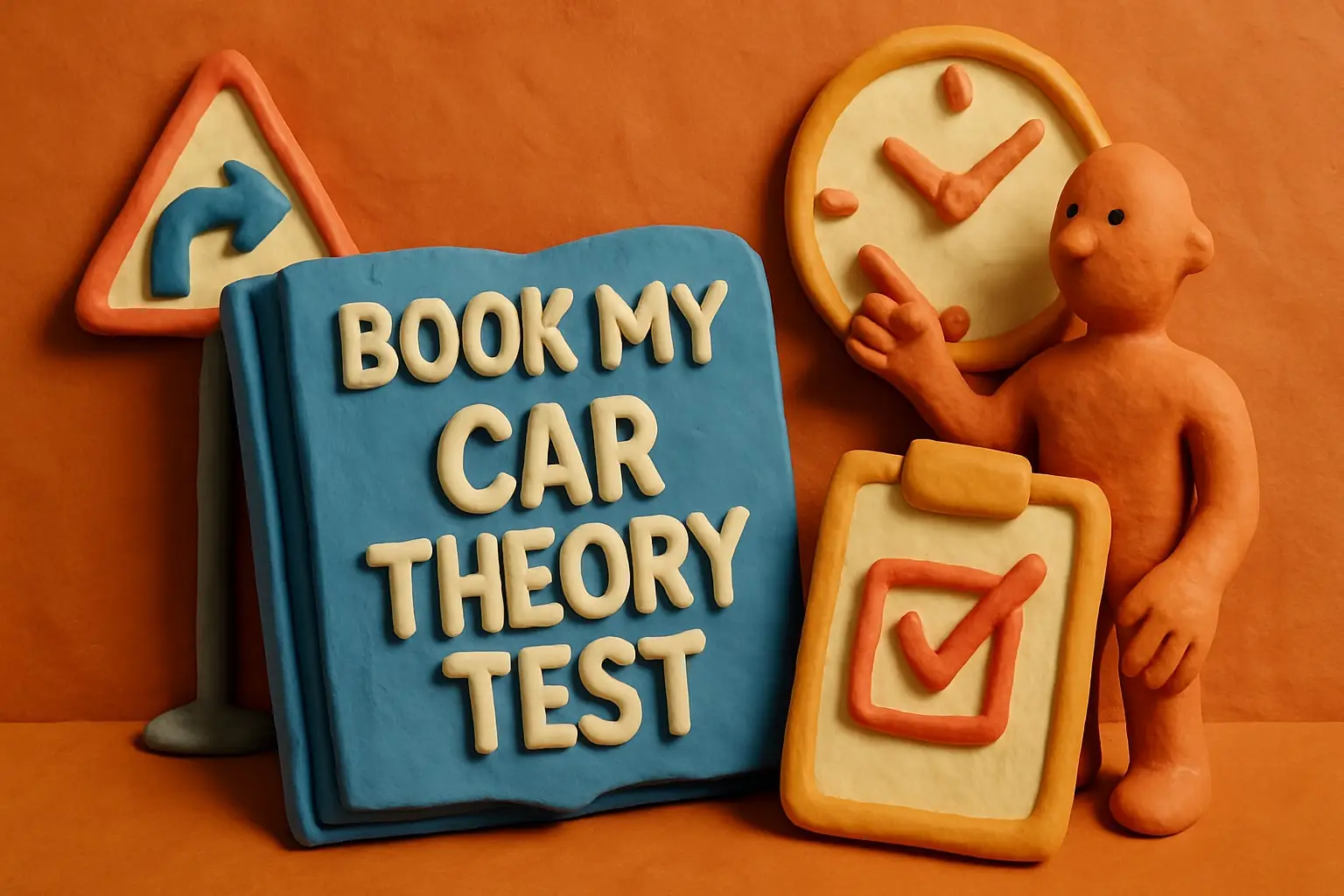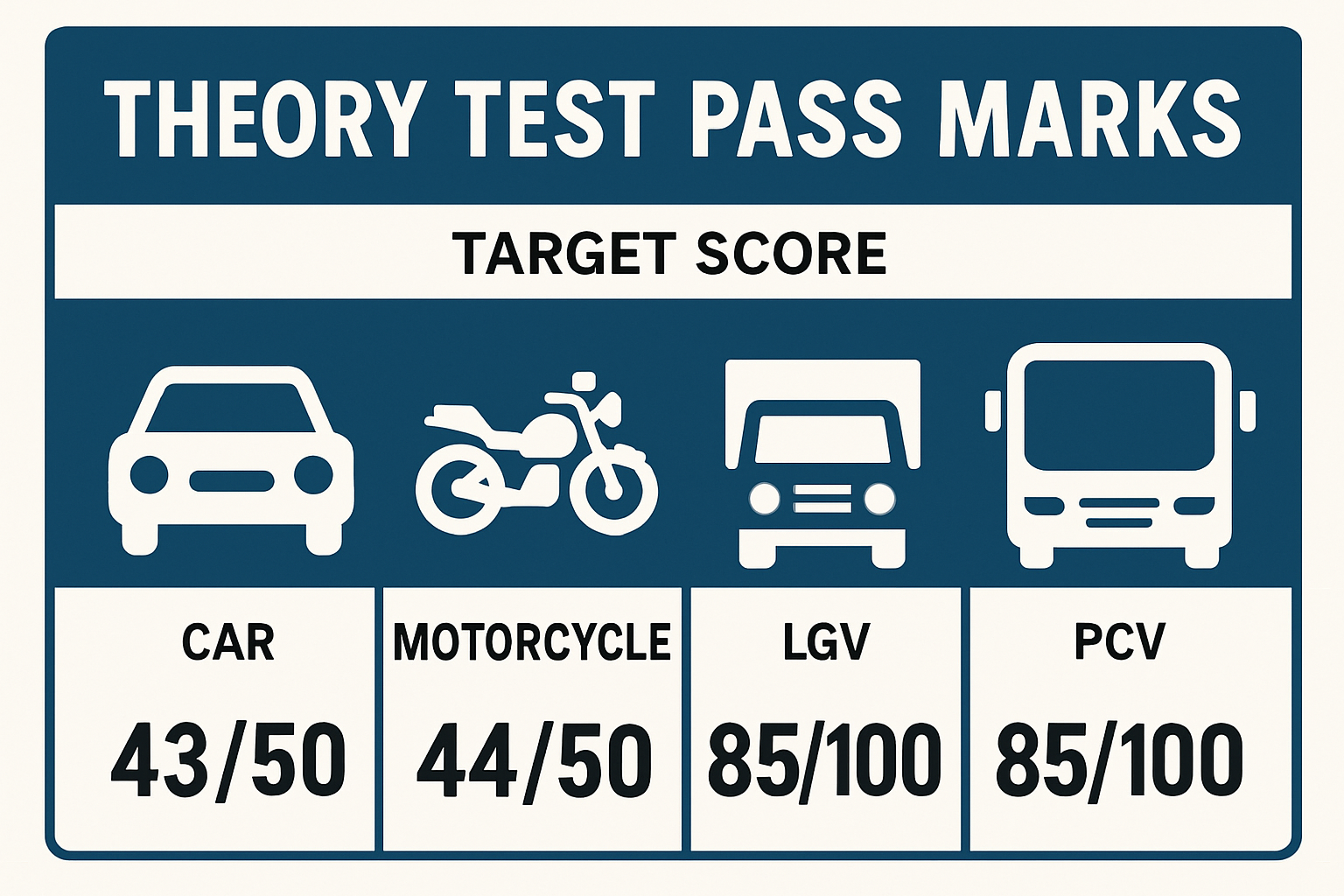Are you finding the theory test practise test more challenging than expected? You are certainly not alone, as many learners share this struggle each year.
This guide is designed to help you overcome those challenges confidently. Inside, you will find proven strategies, essential resources, and a step-by-step approach tailored for the 2025 exam.
You will learn the test format, discover why practice tests are so effective, and get tips for building a study plan that really works. Ready to boost your chances of success? Let’s get started.
Understanding the Theory Test: Format, Content, and Changes for 2025
The UK theory test is a vital step for anyone hoping to get a driving licence. It ensures every learner understands the rules of the road, identifies hazards, and applies safe driving practices. Preparing with a theory test practise test puts you in a strong position to succeed.
What Is the UK Theory Test?
The UK theory test is designed to assess your knowledge of road rules and your ability to recognize hazards. It is required for all learner drivers before they can book a practical driving test. Using a theory test practise test is the most effective way to familiarize yourself with the test structure and expectations.
This test applies to anyone aiming for a car, motorcycle, LGV, PCV, or ADI licence. It provides a consistent standard of safety and awareness for all road users.
Test Format: Multiple-Choice and Hazard Perception
The theory test consists of two main sections. The first is a multiple-choice exam, which covers topics like road signs, traffic regulations, and safe driving principles. The second part is the hazard perception test, where you watch video clips and identify developing hazards as quickly as possible.
A theory test practise test will typically replicate both sections, offering real exam-style questions and interactive hazard perception clips. Practising both formats is essential, as each tests different skills and knowledge areas.
Content Areas and Candidate Types
The theory test covers a broad range of topics, including:
- Road signs and markings
- Traffic laws and regulations
- Hazard recognition and risk management
- Case studies and situational judgement
Candidates from various backgrounds, such as car drivers, motorcyclists, lorry and bus drivers, and driving instructors, must all pass the theory test. Each group may face questions tailored to their specific vehicle category, so using a targeted theory test practise test is important.
2025 Changes to the Theory Test
For 2025, several key updates are being introduced to keep the theory test relevant and challenging. Expect new question types that assess deeper understanding, more interactive digital elements, and an updated syllabus reflecting recent changes in road safety and technology.
There is also a greater focus on scenarios involving advanced driver assistance systems (ADAS) and eco-driving. To stay informed on these changes, review UK Driving Theory Test Rule Changes September 2025, which details the latest updates, including new formats and content.
Adapting your preparation to include these changes is crucial. Using an up-to-date theory test practise test ensures you cover all the new material and question styles.
Pass Rates, Common Pitfalls, and Preparation Insights
Pass rates for the theory test typically range from 47% to 53% across all categories. Many candidates struggle with hazard perception or misinterpret multiple-choice questions. The table below summarizes recent statistics and common pitfalls:
| Section | Average Pass Rate | Common Pitfall |
|---|---|---|
| Multiple-Choice | 55% | Misreading questions |
| Hazard Perception | 50% | Missing developing hazards |
A thorough understanding of the test format and content, supported by regular use of a theory test practise test, is key to overcoming these hurdles. This targeted approach highlights weak areas, builds confidence, and sets you up for success.
The Power of Practice Tests: Why They Work
Preparing for the theory test can feel overwhelming. Many learners spend hours reading the Highway Code, yet still struggle with real exam questions. The key to unlocking success often lies in using a theory test practise test. This proven approach offers more than repetition—it transforms preparation into targeted, effective learning.
The Science Behind Practice Tests
A theory test practise test leverages the power of active recall and spaced repetition. Rather than passively reading, you actively answer questions, strengthening memory pathways. Research shows that repeated testing enhances long-term retention far more than simply reviewing notes.
Practice also exposes you to various question formats. This gives your brain a wider context for each concept, making it easier to retrieve information under exam pressure. The more often you use a theory test practise test, the more comfortable you become with the way knowledge is assessed.
Mirroring the Real Exam
One of the greatest strengths of a theory test practise test is its ability to recreate the actual DVSA exam environment. You experience the same types of multiple-choice and hazard perception questions, time limits, and interface as the real test.
This familiarity reduces anxiety and builds confidence. Additionally, using a theory test practise test highlights areas where you may hesitate or make mistakes, allowing you to address them before exam day.
| Real Exam Feature | Mirrored in Practise Test? |
|---|---|
| Multiple-choice format | Yes |
| Hazard perception videos | Yes |
| Timed sections | Yes |
| Randomized questions | Yes |
Benefits of Regular Practice
Regularly completing a theory test practise test provides measurable advantages. Studies indicate pass rates increase significantly for learners who incorporate practice tests into their study routine. Test-takers report feeling less anxious and more in control.
Benefits include:
- Reduced exam stress due to familiarity with the format
- Improved knowledge retention through repeated exposure
- Greater awareness of tricky question wording and common pitfalls
- Ability to focus revision on weak areas
For hazard perception, targeted practice is crucial. Accessing Free Hazard Perception Tests can help you hone your skills and boost your overall score.
Case Study & Insights
Consider a candidate who switched from reading the Highway Code to using a theory test practise test daily. Their scores improved from 65% to over 90% within three weeks. This example highlights how practice tests are both diagnostic and motivational, revealing knowledge gaps and tracking progress.
Relying solely on reading is not enough. Practice tests provide the real feedback and confidence needed to succeed on test day.
Step-by-Step Guide: Structuring Your Theory Test Study Plan
Preparing for the theory test can feel overwhelming, especially with new changes in 2025. The right strategy makes all the difference. This step-by-step guide breaks down how to use a theory test practise test as your foundation for success, ensuring you cover every essential aspect of your preparation.
Step 1: Assess Your Starting Point
Begin your journey by taking an initial theory test practise test. This first attempt is not about passing, but about identifying your strengths and weaknesses. Review your results carefully to spot which sections, such as hazard perception or road signs, need more attention.
Consider exploring resources like Theory Test Explained to understand the format and what to expect. With this insight, you can tailor your study plan to focus on the areas where you need the most improvement.
For example, if your hazard perception score is low, prioritize that in your revision. This approach ensures your time is spent where it matters most.
Step 2: Gather the Right Study Materials
Once you know your starting point, assemble high-quality, up-to-date resources. Use the latest Highway Code, official DVSA question banks, and digital hazard perception clips. Choosing the right study materials is essential, as the theory test practise test relies on current information to mirror the real exam.
Look for materials updated for 2025, including interactive apps and printed guides. Double-check that your resources reflect the latest changes to the test, such as new question types or technology topics. This preparation prevents surprises on exam day.
Organize your materials so they are easy to access during each study session, whether you prefer digital or print formats.
Step 3: Set a Realistic Study Schedule
Effective preparation requires a structured timetable. Create a weekly planner that balances theory revision, mock tests, and practical driving lessons. Allocate specific times for each topic, such as road signs or hazard perception, using your initial theory test practise test results as a guide.
Consistency is key. Aim for shorter, regular study sessions instead of cramming. For instance, spend 30 minutes daily reviewing questions and another 30 minutes practicing hazard perception clips. This approach helps build knowledge steadily and avoids burnout.
Adjust your schedule as needed, especially if you notice certain areas need extra attention.
Step 4: Practice, Review, and Track Progress
Regular practice is essential. Take a theory test practise test daily or weekly to reinforce your knowledge. After each session, review incorrect answers and read the explanations thoroughly. This deeper understanding helps you avoid repeating mistakes.
Keep a log of your scores and note which topics consistently challenge you. Use digital trackers or a simple spreadsheet to monitor your progress. Over time, you will see patterns and improvements, which builds confidence and highlights areas for further revision.
Remember, quality practice beats quantity—reflect on each mistake to maximize your learning.
Step 5: Simulate Real Exam Conditions
As your exam date approaches, simulate real test conditions. Take full-length, timed theory test practise test attempts in a quiet setting. Remove distractions, use only allowed materials, and follow the official timing.
This simulation builds stamina and familiarizes you with the pressure of the real exam. It also highlights time management issues, such as spending too long on certain questions. After each mock exam, review your performance and adjust your study plan accordingly.
Practicing under realistic conditions ensures you walk into the actual test center feeling prepared and confident.
Maximizing Practice Test Sessions: Expert Tips and Common Mistakes
Maximizing your theory test practise test sessions is crucial for turning study time into real results. Many learners take multiple practice tests, but only those who use strategic techniques see consistent improvement. By applying expert tips and avoiding common pitfalls, you can make every minute count and boost your confidence on exam day.
Best Practices for Effective Practice Test Sessions
To get the most out of each theory test practise test, consistency and structure are key. Schedule regular sessions, aiming for shorter, focused tests rather than marathon study blocks. This helps you retain information and reduces burnout.
- Simulate exam conditions: Sit in a quiet room, set a timer, and avoid distractions.
- Review immediately: After each session, go through your answers and note mistakes.
- Mix question types: Practice both multiple-choice and hazard perception in each sitting.
A well-structured routine ensures that every theory test practise test brings you closer to your goal. Remember, quality practice is more valuable than sheer volume.
Turning Results Into Targeted Revision
Analyzing your performance on each theory test practise test is essential for effective learning. Track the questions you get wrong and group them by topic. This makes it easy to spot patterns and address weak areas.
Consider using a simple table to log your results:
| Date | Score (%) | Weak Area | Action Plan |
|---|---|---|---|
| 01/05/2025 | 68 | Road Signs | Review Highway Code |
| 03/05/2025 | 74 | Hazard Perception | Watch DVSA video clips |
| 06/05/2025 | 81 | Stopping Distances | Create flashcards |
Use the insights from your theory test practise test to focus revision sessions. For candidates struggling with specific question types, resources like Difficult Theory Test Questions Explained can help clarify challenging concepts and boost accuracy.
Common Mistakes and How to Avoid Them
Many learners fall into traps that limit their progress on the theory test practise test. Here are the most common mistakes and how to sidestep them:
- Guessing without learning: Always review explanations, even for correct answers.
- Skipping explanations: Understanding why an answer is right or wrong cements knowledge.
- Over-relying on memorization: Focus on understanding principles, not just recalling facts.
Avoiding these errors ensures every theory test practise test becomes a learning opportunity. Candidates who review every mistake can improve their pass rates by up to 30%.
Mastering Hazard Perception and Category-Based Practice
Hazard perception often feels daunting, but with the right approach, it becomes manageable. Use video clips to practice identifying developing hazards early. Pay close attention to subtle cues, such as brake lights or changing traffic flow, to improve your reaction time.
Break your theory test practise test sessions into categories like road signs, alertness, and safety margins. This targeted practice helps reinforce weak areas and builds comprehensive understanding.
Spaced repetition is another powerful technique. By revisiting challenging topics at intervals, you strengthen memory retention and ensure knowledge sticks for the long term.
Maximizing your theory test practise test sessions is all about smart strategies, regular reflection, and a willingness to learn from every attempt. Approach each session with intent, and you'll see measurable progress on your journey to success.
Essential Resources for 2025 Theory Test Preparation
Preparing for the 2025 theory test demands more than just reading a manual. The right mix of up-to-date resources can make the difference between passing and retaking your exam. With the theory test practise test at the core of your study routine, selecting effective tools is crucial for success.
Official and Recommended Study Materials
Start with the essentials. The official DVSA apps and the Highway Code 2025 edition should be your primary reference. These provide the most accurate, current information on rules, road signs, and hazard awareness. For the theory test practise test, look for platforms that use real DVSA questions and offer practice in both multiple-choice and hazard perception formats.
Many candidates benefit from comprehensive platforms like UK Driving Theory Test Practice 2025 which align with the latest exam updates. These sites often include full-length mock exams, interactive case studies, and feedback to help you target weak areas.
Comparing Free vs. Paid Resources
Choosing between free and paid options can impact your preparation. Here is a quick comparison:
| Resource Type | Free Options | Paid Options |
|---|---|---|
| Mock Tests | Limited, outdated Qs | Full, updated Qs |
| Hazard Perception | Few sample clips | Extensive video library |
| Flashcards | Basic, user-made | Curated, exam-focused |
| Apps | Ads, feature limits | Ad-free, progress tracking |
While free tools are useful for initial exposure, paid resources often provide a richer, more realistic theory test practise test experience. They include detailed explanations, performance tracking, and regular updates to reflect DVSA changes.
Leveraging Flashcards and Mobile Apps
Revision flashcards are excellent for reinforcing knowledge on the go. Digital sets like the Theory Test Practice Flashcards target key facts, road signs, and tricky rules. Integrate flashcards into your daily routine—review them during commutes or short study breaks for consistent progress.
Mobile apps can also boost your theory test practise test results. Many apps sync with your progress, remind you to study, and allow for quick quizzes anywhere. Choose apps that are updated for 2025 and offer a mix of question types, including hazard perception.
Selecting the Right Resource Mix for Your Learning Style
Every learner is different. Visual learners may prefer video clips and infographics, while others benefit from reading or interactive quizzes. When building your theory test practise test toolkit, combine resources that match your preferences.
If you learn best through repetition, prioritize platforms with unlimited mock tests. For those who prefer concise study, flashcards and summary guides work well. Regularly check for updates to ensure your materials align with the latest test content and technology.
Staying current with your resources is vital. The 2025 theory test introduces new question types and a greater focus on safety and technology, so always verify that your study tools reflect these changes. The right resource mix not only saves time but also gives you the confidence and accuracy needed to ace your exam.
Test Day Strategies: How to Succeed Under Pressure
Preparing for your theory test practise test is about more than just studying content. Success on test day comes from planning ahead, managing stress, and applying proven strategies in the exam room. Here’s how to approach the big day with confidence and composure.
Pre-test Checklist: Be Ready Before You Arrive
A smooth theory test practise test experience starts with practical preparation. Review this checklist the night before:
- Bring your provisional driving licence or required ID.
- Check your test booking confirmation for exam location and time.
- Arrive at least 30 minutes early to avoid last-minute stress.
- Pack glasses or contact lenses if you need them for reading.
- Leave bags, mobile phones, and notes in the designated area as required.
Staying updated on any upcoming changes to UK driving tests in 2025 ensures you are not caught off guard by new requirements or formats.
Managing Nerves: Staying Calm and Focused
Even well-prepared candidates can feel anxious before their theory test practise test. Use these techniques:
- Practice slow, deep breathing to calm your mind.
- Visualize yourself answering questions confidently and passing.
- Remind yourself of your preparation and progress.
- Use positive self-talk, such as “I am ready for this.”
Remember, nerves are normal, but consistent practice and familiarization with the test format help reduce anxiety significantly.
Time Management: Pacing Yourself for Success
Effective time management is crucial during your theory test practise test. Here’s how to stay on track:
- Allocate time for each section: do not linger too long on difficult questions.
- For multiple-choice, flag uncertain questions and return to them later.
- In hazard perception, trust your instincts and react promptly.
- Regularly glance at the on-screen timer to monitor your pace.
These habits, built during your practice sessions, translate directly to exam day success.
Reading Questions Carefully & What to Do If You Get Stuck
Careful reading can make the difference between a pass and a fail in your theory test practise test.
- Read each question twice to catch details or tricky wording.
- Watch for “all of the above” or “none of the above” options.
- If stuck, use the process of elimination to rule out obvious wrong answers.
- Make an educated guess if unsure, as unanswered questions score zero.
- Flag questions to revisit if time permits.
For 2025, expect new question types and scenarios, especially those focused on safety and technology. Review the 2025 theory test update to understand what’s different this year.
Success Stories & Final Insights
Many candidates have overcome pre-test anxiety by simulating exam conditions with regular theory test practise test sessions. One learner credited daily mock tests for building confidence, allowing them to stay composed even when faced with unexpected questions.
Preparation is the foundation of composure. Knowing the test format, having the right documents, and practicing under timed conditions all contribute to a calm, focused mindset. On test day, trust your preparation, manage your time, and approach each question methodically. With the right strategies, you will turn nerves into determination and walk out with a passing result.
You have seen how targeted practice, the right resources, and a clear study plan can make all the difference in your theory test success. Now, it is time to put your knowledge into action and start practicing with real DVSA-style questions and hazard perception clips. If you want to boost your confidence, track your progress, and truly understand what the exam will be like, there is no better way than taking high-quality practice tests. Ready to take the next step toward passing your 2025 theory test? Practice for free and see how much you can improve before exam day.
Contents
- 1 Understanding the Theory Test: Format, Content, and Changes for 2025
- 2 The Power of Practice Tests: Why They Work
- 3 Step-by-Step Guide: Structuring Your Theory Test Study Plan
- 4 Maximizing Practice Test Sessions: Expert Tips and Common Mistakes
- 5 Essential Resources for 2025 Theory Test Preparation
- 6 Test Day Strategies: How to Succeed Under Pressure

